This post may contain affiliate links. Please read my privacy policy.
Discover the best grilled fish ever! This Malaysian ikan bakar, or grilled fish wrapped in banana leaves, is moist, aromatic, and tantalizingly delicious. This ultimate grilled fish recipe promises an explosion of flavor that you just can't stop eating.
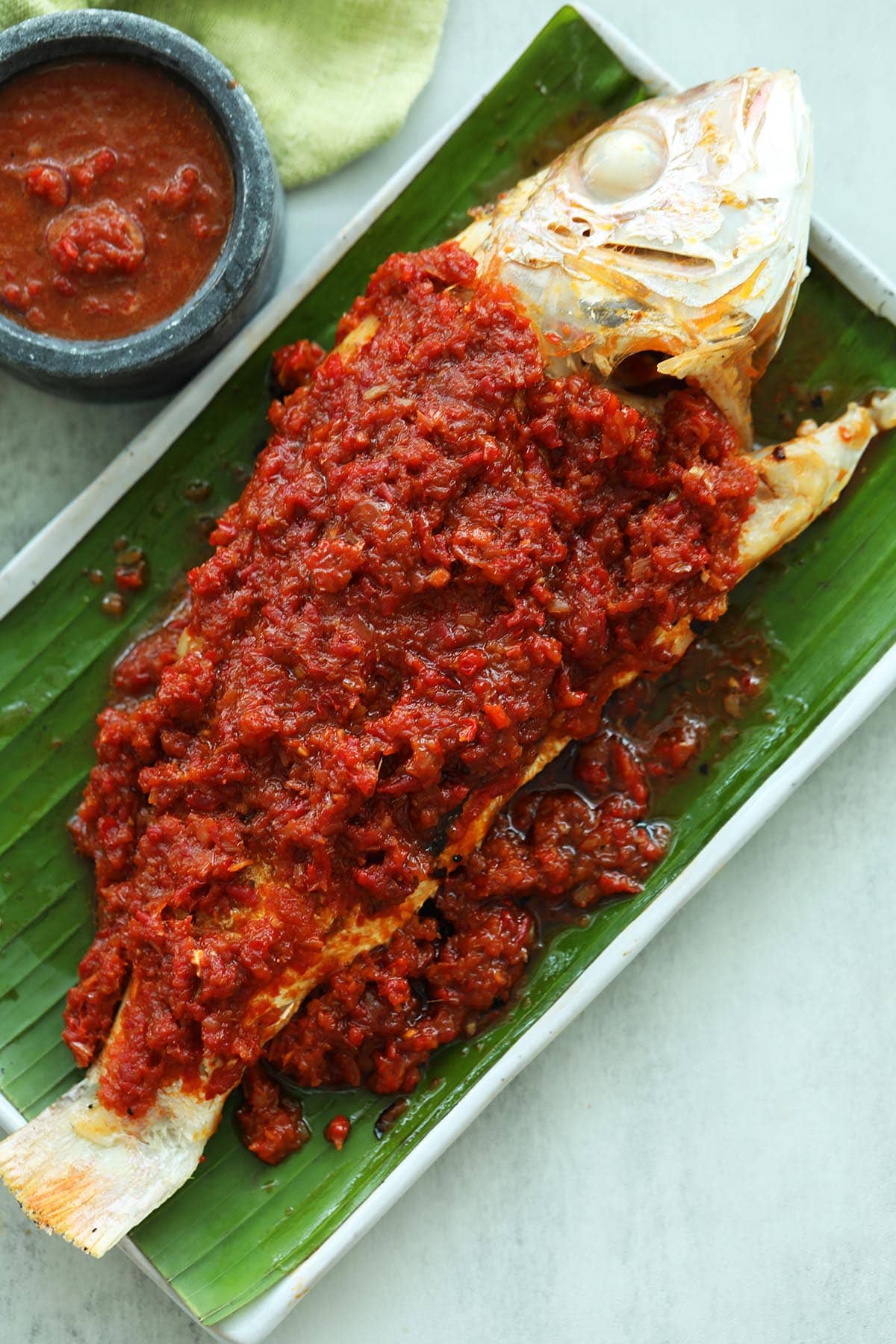
The Best Grilled Fish Recipe
I hail from Penang, a Malaysian island teeming with abundant fish caught off its shores, and among our many outstanding fish dishes, none surpasses the exquisite flavors of grilled fish, especially the ones grilled in banana leaves and marinated with sambal —a spice paste and marinade for fish. It’s spicy, aromatic, pungent, salty, sweet, with perfect balance of taste.
Locally known as ikan bakar or ikan panggang, envision succulent grilled whole fish, delicately marinated in spices, then enveloped in banana leaves before being grilled or cooked to utter perfection! Just the thought of it has my taste buds dancing in anticipation.
I developed this grilled fish recipe from scratch; it’s very accessible because it’s cooked in a pan on the stove top. If you have an outdoor grill, you can try spicy grilled fish. As it’s cooked indoor, your kitchen will be filled with the aroma of sizzling grilled fish wafted through the air, enticing the senses with its tantalizing flavors.
This is the most authentic and best grilled fish recipe you will find online!
Banana Leaves For Cooking
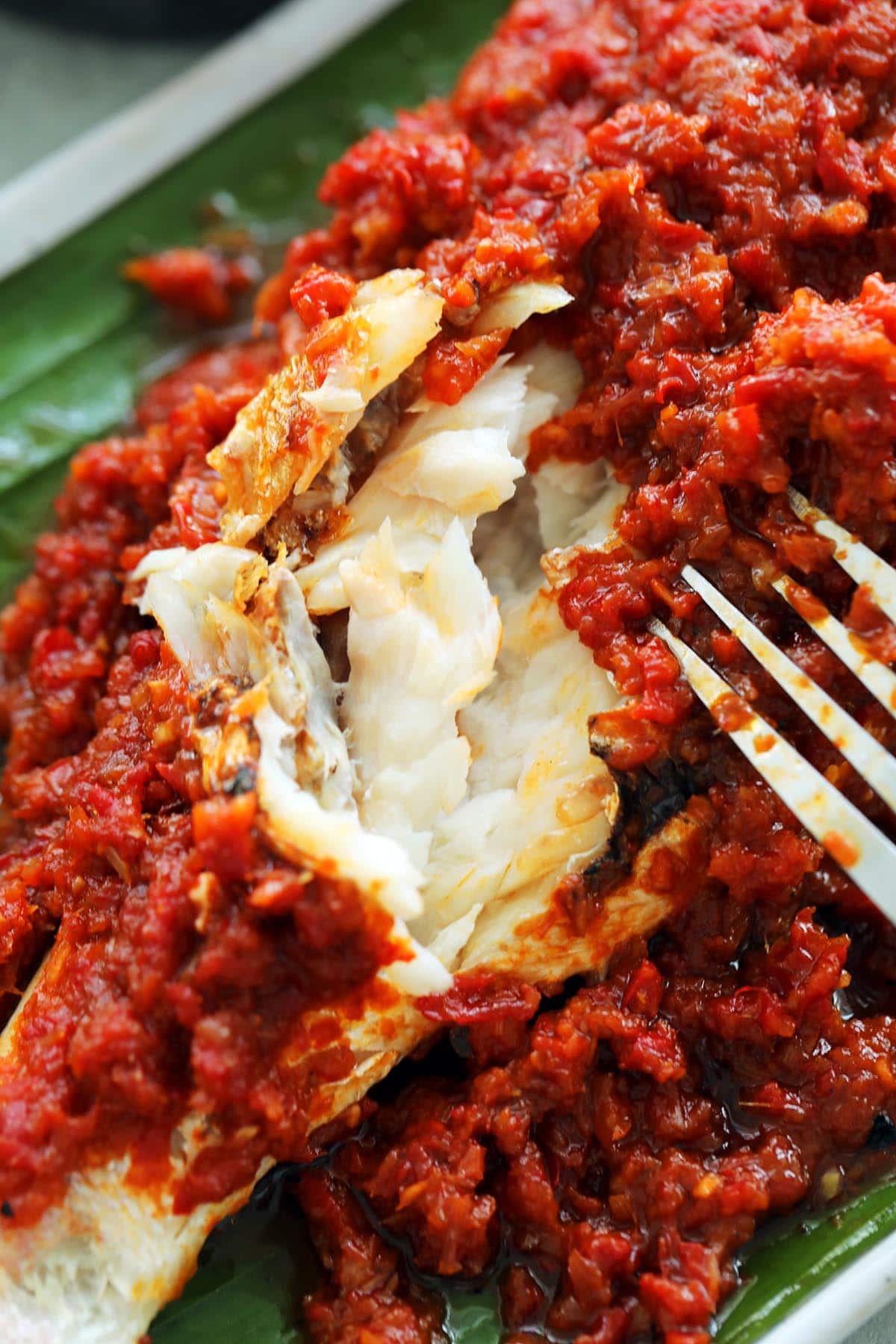
In Southeast Asia, including countries like Malaysia, Indonesia, and Thailand, cooking with banana leaves is a cherished culinary tradition. Banana leaves aren’t just wraps; they work wonders when grilling fish. In these regions, large banana leaves serve as natural, eco-friendly wraps, imparting a special earthy aroma to a variety of foods.
Using banana leaves when grilling fish also help prevent the fish from sticking to the bottom, and hence keeping the fish moist and tasty. As the fish cooks, the banana leaves release a lovely and charred aroma, adding a tropical twist to your dish. Presentation wise, banana leaves also make the grilled fish look rustic and authentic, enhancing the dining experience.
Banana leave recipes include not only grilled fish and nasi lemak, but a variety of sweet treats such as onde-onde, pulut inti, and kuih bengka. Other than that, they are also used for serving food. I am a huge fan of banana leaves food; they are undoubtedly rustic and traditional compared to modern-day plastic boxes and shrink-wrapped foods.
Ingredients For Grilled Fish
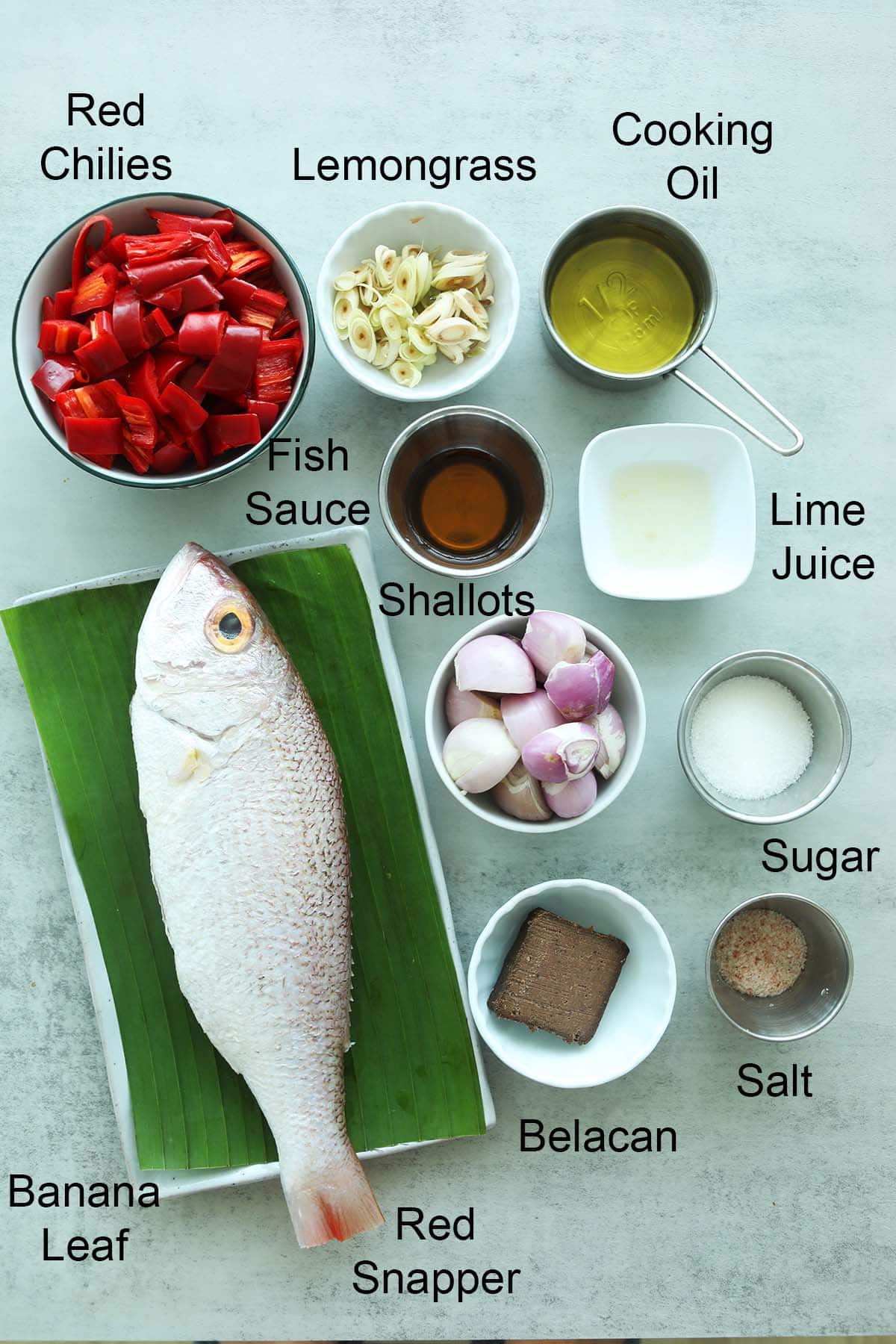
My recipe is structured into three main steps: the fish, the marinade (sambal), and the grilled fish dipping sauce. For my grilled fish recipe, you will need the following ingredients:
- Red or white snapper: There are two types of snapper—red and white. Both are excellent choices for grilling, with the difference lying in their color and appearance. For my recipe, I opted for white snapper.
- Banana leaves: They are used to wrap the fish and to serve the final finished dish.
Grilled Fish Marinade Ingredients
My grilled fish recipe calls for sambal, or Malaysian spice paste as the marinade. The sambal is made of:
- Red Chilies – fresh red chilies are used in my sambal, giving it the freshest taste possible.
- Shallots
- Lemongrass
- Belacan – Malaysian shrimp paste.
- Fish Sauce – lends a deeper umami flavor to the sambal.
- Lime Juice
- Cooking Oil
- Salt
- Sugar
Grilled Fish Dipping Sauce Ingredients
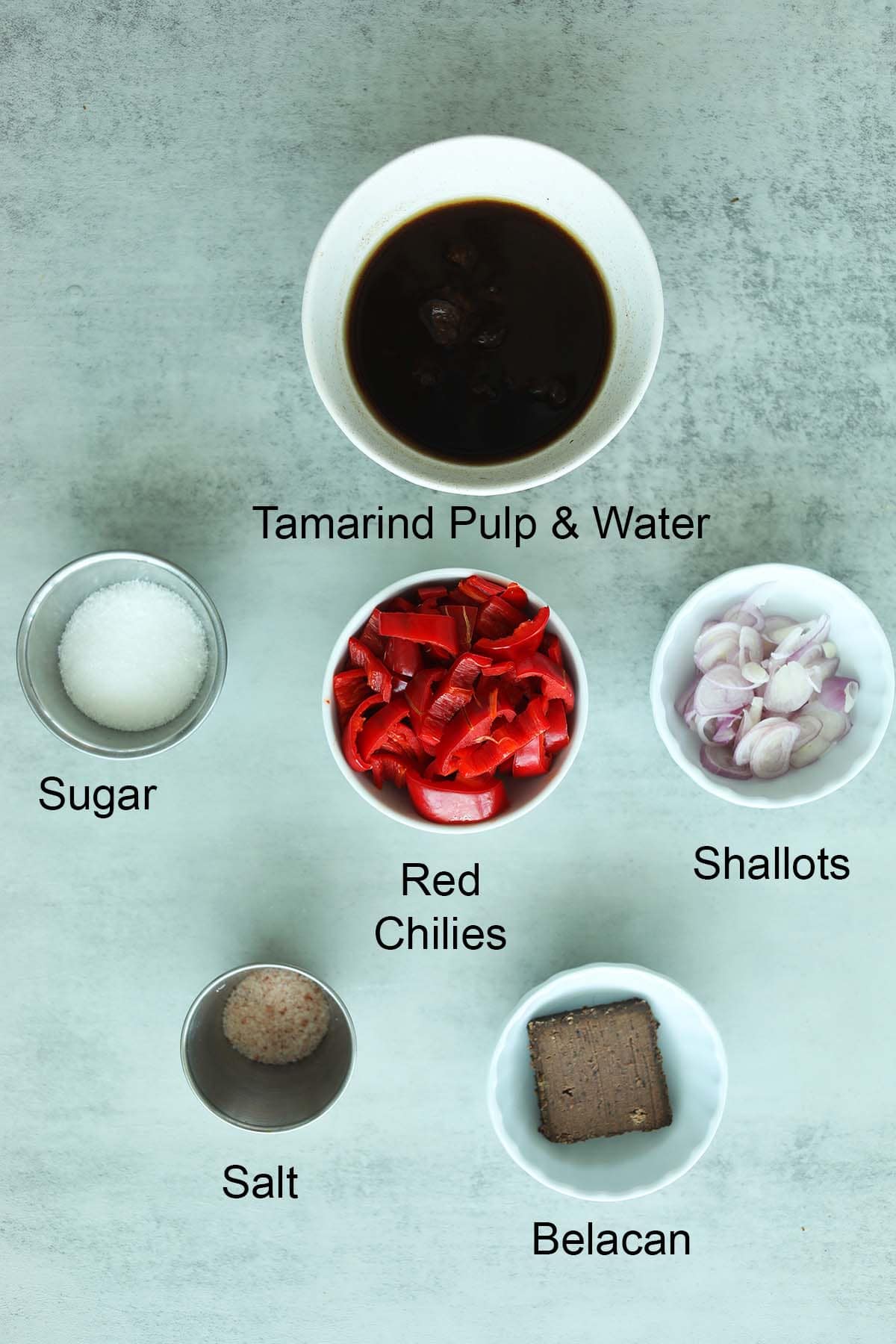
Grilled fish is often served with a dipping sauce made with the following ingredients:
- Red Chilies
- Shallots
- Belacan
- Tamarind pulp & water
- Sugar
- Salt
How To Make Grilled Fish Sambal
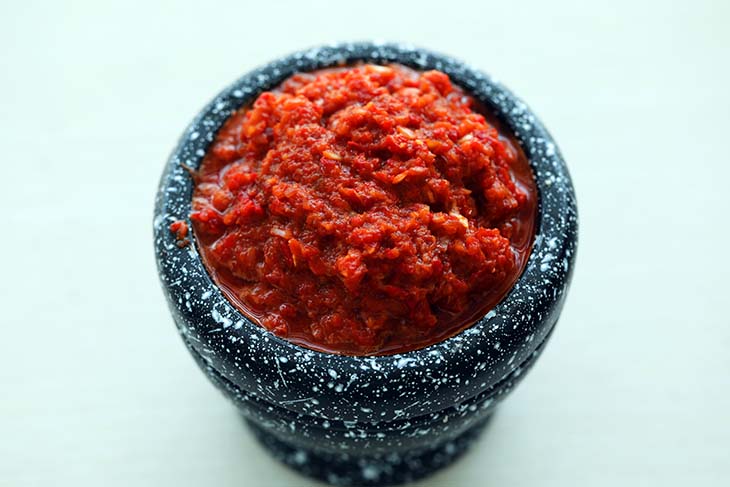
Step 1: Prepare the sambal by grinding chilies, shallots, belacan, and lemongrass in a food processor, ensuring that the sambal paste is well blended and smooth.
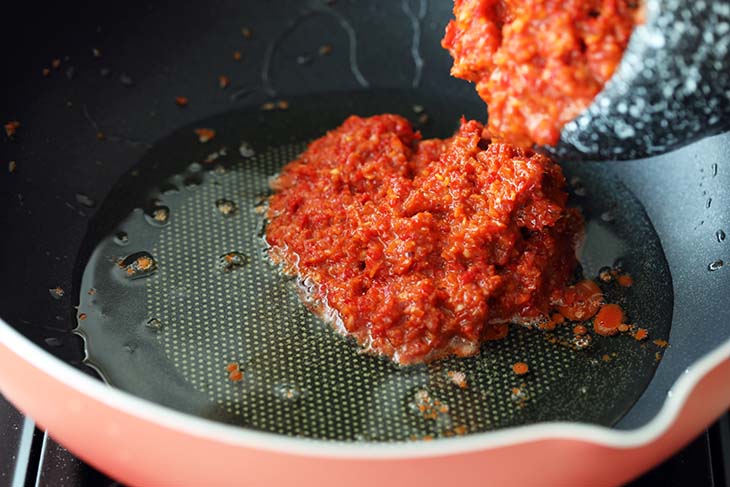
Step 2: Heat up a wok and “tumis” (stir-fry) the sambal paste until aromatic or when the oil separates from the sambal paste.
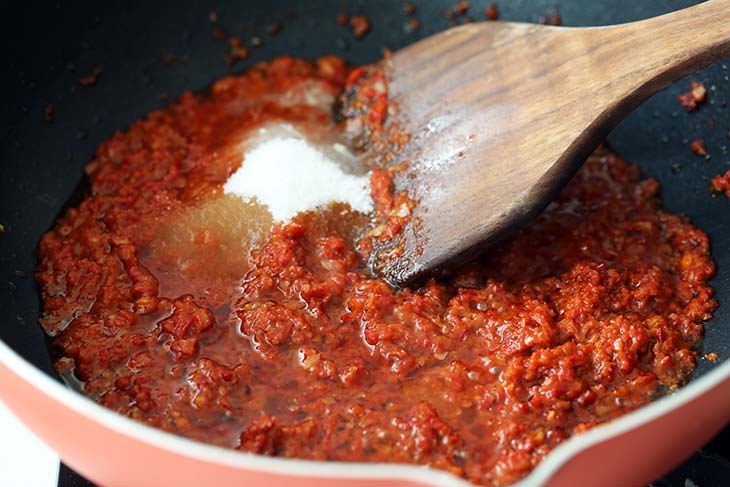
Step 3: Add the seasonings: salt, sugar, and fish sauce and do a quick stir.
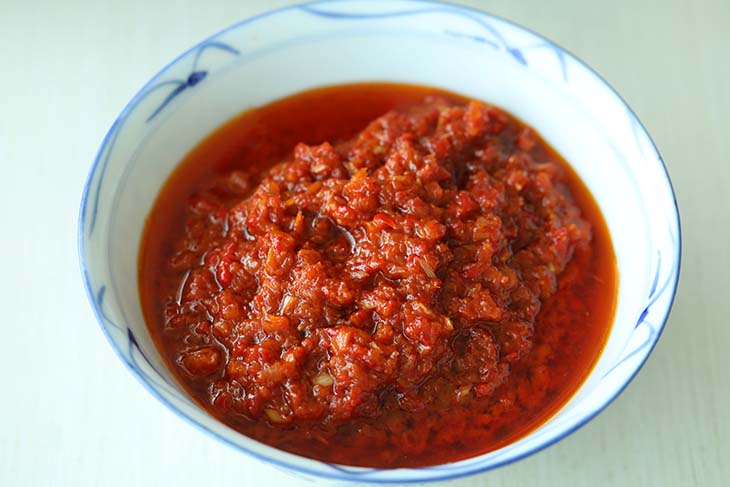
Step 4: Dish out and set aside.
How To Cook Grilled Fish
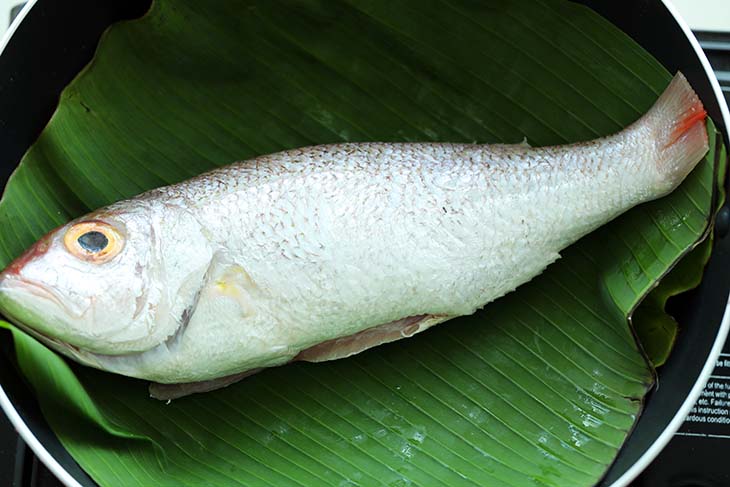
Step 1: Grease a pan and lay a few sheets of banana leaves in it. Add 1 tablespoon of cooking oil on top of the banana leaves, spreading the oil evenly. Place the fish on top of the banana leaves.
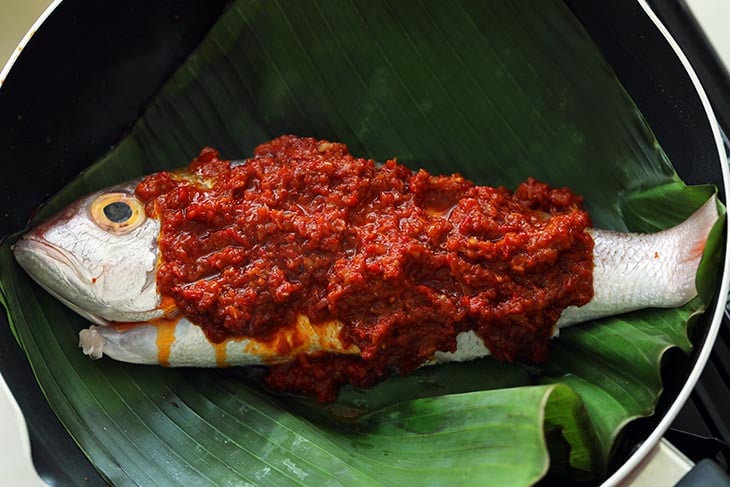
Step 2: Add 3 tablespoons of sambal on top of the fish.
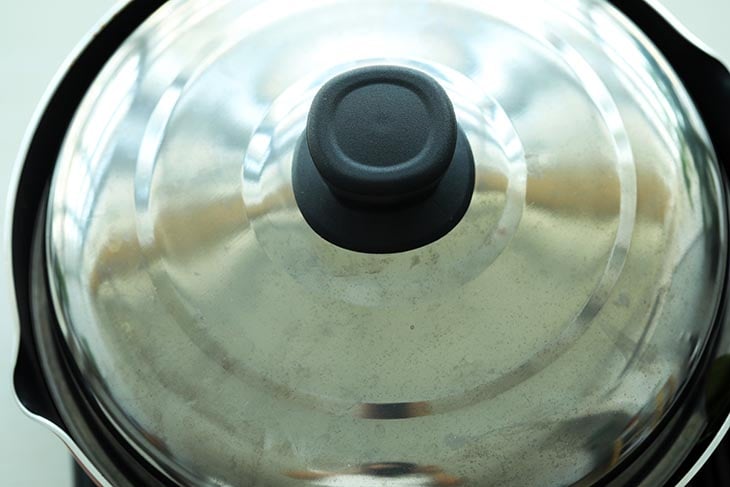
Step 3: Heat the pan on your stovetop over medium heat and cover it with a lid.
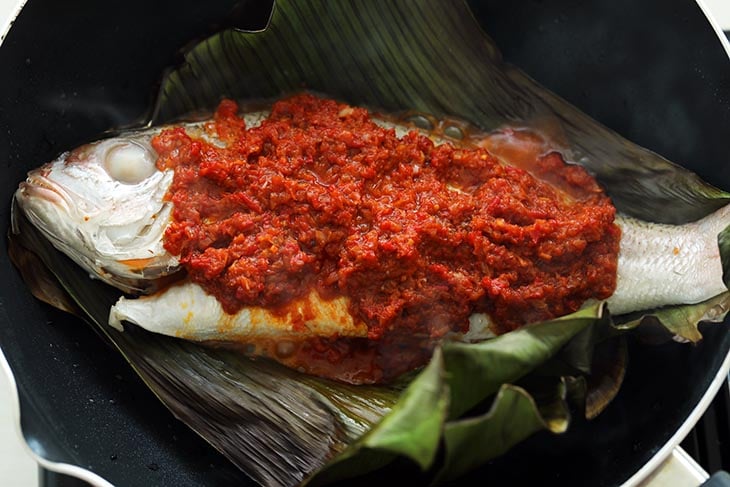
Step 4: Cook the grilled fish for about 8 minutes, then flip the fish over to the other side.
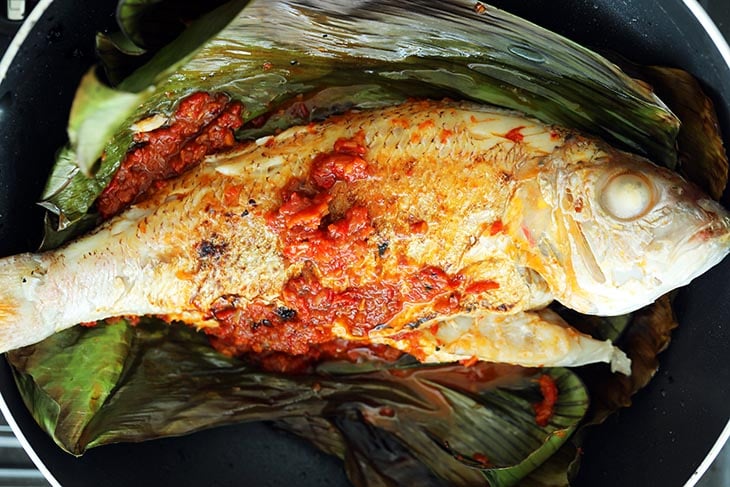
Step 5: Add 3 more tablespoons of sambal to the other side.
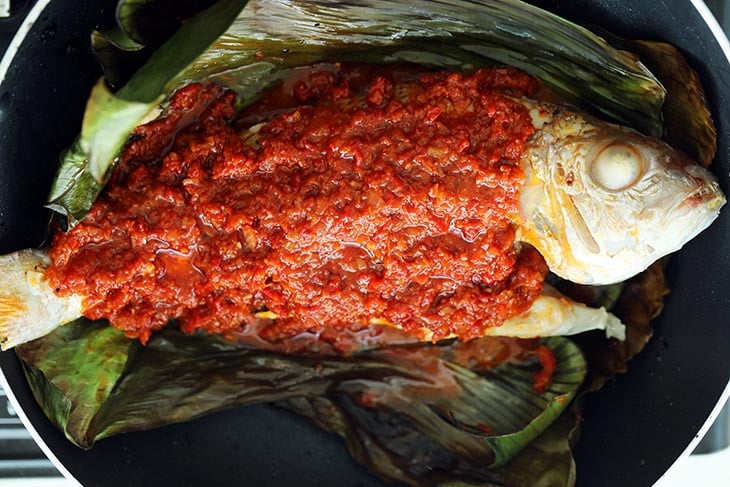
Step 6: As soon as you smell the sweet aroma of burnt banana leaves, the grilled fish is cooked. Dish it out and serve immediately with the Grilled Fish Dipping Sauce.
Pro Tips: You can grill fish on an outdoor grill or use the stovetop for cooking. If you cannot find fresh or frozen banana leaves in your supermarket or food stores, you may grill fish using aluminum foil.
Frequently Asked Questions
If you are in Asia, you may find fresh banana leaves at fresh food wet markets or local markets. Alternatively, if you are lucky, you can simply cut a few leaves from a banana tree nearby. If you are in the United States, Australia, or the United Kingdom, you can purchase frozen banana leaves in a plastic package at Asian stores. They are typically found in the frozen food section.
You can make grilled fish in foil by cutting off a sheet or two of aluminum foil to wrap the fish before grilling.
To clean banana leaves, you may rinse both sides of the leaves with cold water and then pat them dry with paper towels. Alternatively, you can use a damp cloth to wipe the surface.pe the surface.
The grilling time depends on the thickness of the fish fillet used. My recipe calls for a whole fish, so cook and grill the fish for about 6-8 minutes on each side, flipping over to the other side and grill for another 6-8 minutes.
When fish is cooked, it turns opaque, flakes easily, smells pleasant, and may have slightly dry surface. If you are cooking a whole fish, the eyeballs will no longer be translucent; in fact, they will turn opaque or white in color.
The internal temperature of cooked fish should reach 145°F (63°C) according to food safety guidelines.
This recipe is only 325 calories per serving.
I highly encourage you to give this grilled fish recipe a try. I’ve included a step-by-step picture guide in the post above for your convenience. I believe my late grandmother and parents would have been immensely proud of me if they had tasted my grilled fish recipe. It truly is exceptional!
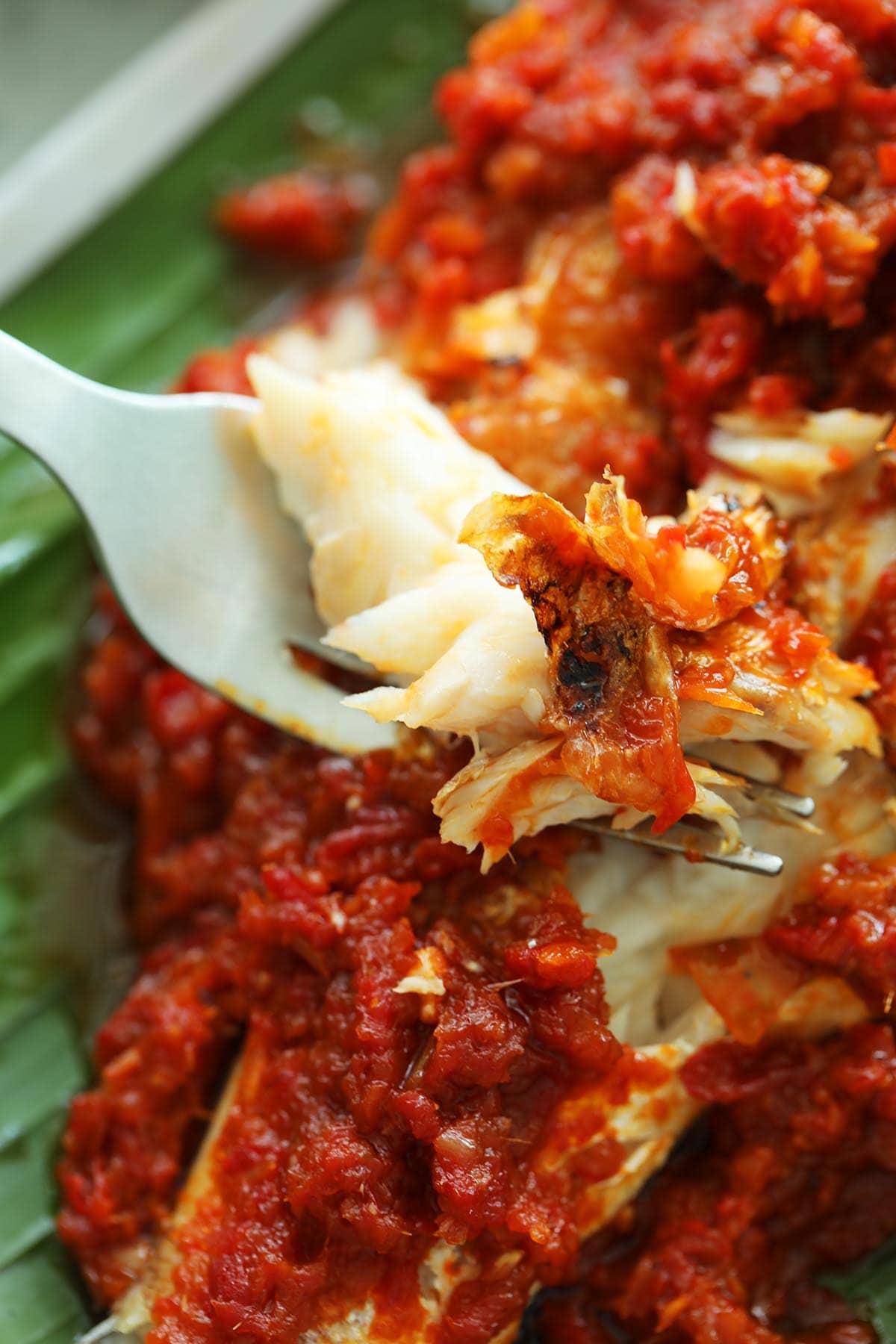
What To Serve With This Recipe
For a complete Malaysian meal at home, I recommend the following recipes:
I hope you enjoy this post as much as I do. If you try my recipe, please leave a comment and consider giving it a 5-star rating. For more easy and delicious recipes, explore my Recipe Index, and stay updated by subscribing to my newsletter and following me on Facebook, Pinterest, and Instagram for new updates.
Other Recipes You Might Like

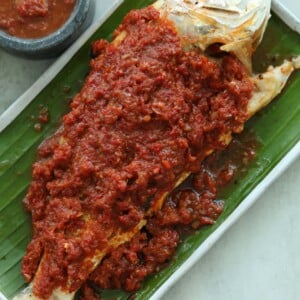
Grilled Fish Recipe
Ingredients
Grilled Fish Sambal:
- 6 oz (175g) fresh red chilies, seeded and cut into small pieces
- 4 oz (125g) shallots
- 2 lemongrass, cut into thin slices, use white part only
- 1 tablespoon toasted belacan, Malaysian shrimp paste
- 2 teaspoons fish sauce
- 1/2 lime, extract juice
- 1/4 teaspoon salt, or to taste
- 2 teaspoons sugar, or to taste
Grilled Fish:
- 1 lb (500g) red or white snapper, cleaned and scales removed
- 3-4 sheets banana leaf
- 4 tablespoons oil
Grilled Fish Dipping Sauce:
- 1/2 cup water plus tamarind pulp, size of a small ping pong ball
- 3 fresh red chilies, seeded
- 2 bird’s eye chilies, seeded, optional
- 1 teaspoon toasted belacan
- 1/4 teaspoon sugar
- Salt, to taste
- 2 shallots, thinly sliced
Instructions
- To cook grilled fish, grease a pan and line it with a few sheets of banana leaves. Drizzle 1 tablespoon of cooking oil over the leaves, spreading it evenly. Place the fish on top of the banana leaves.
- Add 3 tablespoons of sambal on top of the fish. Heat the pan over medium heat on your stovetop and cover it with a lid. Cook the grilled fish for about 8 minutes, then flip it over. Add 3 more tablespoons of sambal to the other side and cook for another 8 minutes.
- The grilled fish is done when you smell the sweet aroma of burnt banana leaves. Dish out and serve immediately with the Grilled Fish Dipping Sauce.
Grilled Fish Sambal
- Prepare the sambal by grinding the chilies, shallots, belacan, and lemongrass in a food processor. Blend until the sambal paste is smooth and well combined.
- Heat a wok and stir-fry the sambal paste until aromatic or until the oil separates from the paste. Add the seasonings—salt, sugar, and fish sauce—and give it a quick stir. Dish out and set aside.
Grilled Fish Dipping Sauce (Optional)
- Add water to the tamarind pulp and mix well. Let it sit for 15 minutes, then extract the tamarind juice and discard the pulp. In a mortar and pestle or food processor, pound or blend the red chilies, bird’s eye chilies, and toasted belacan. Combine the tamarind juice, sugar, salt, and sliced shallots with the sambal. Stir well and set aside.
Notes
- You can grill fish on an outdoor grill or use the stovetop for cooking.
- If you cannot find fresh or frozen banana leaves in your supermarket or food stores, you may grill fish using aluminum foil.
- Grilled fish dipping sauce is optional. The fish is delicious as is.
- How to clean banana leaves? Clean the banana leaves by rinsing with cold water, and then pat dry with paper towels.
- There are two types of snapper—red and white. Both are excellent choices for grilling, with the difference lying in their color and appearance. For my recipe, I opted for white snapper.
- Banana leaves: They are used to wrap the fish and to serve the final finished dish.
Nutrition
Nutrition information is automatically calculated, so should only be used as an approximation.
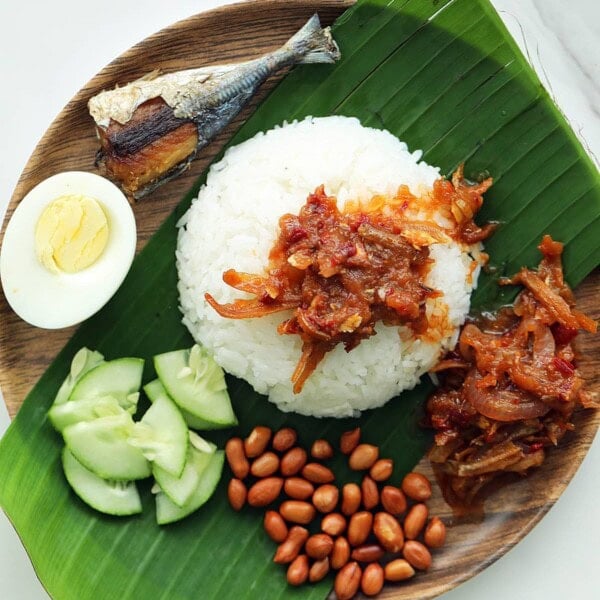
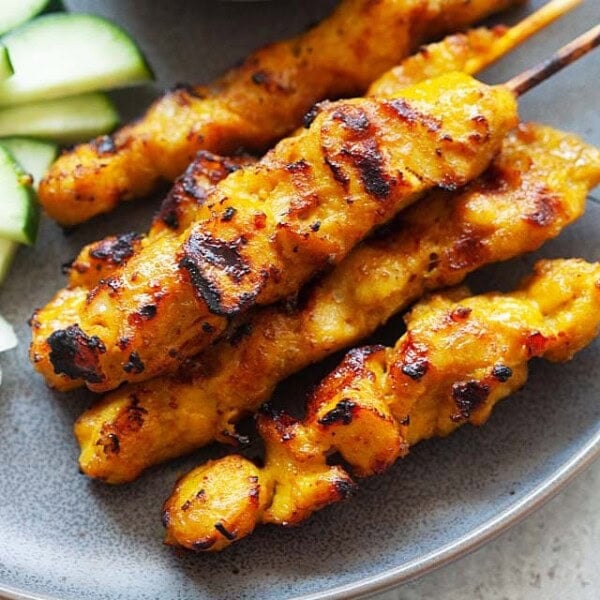
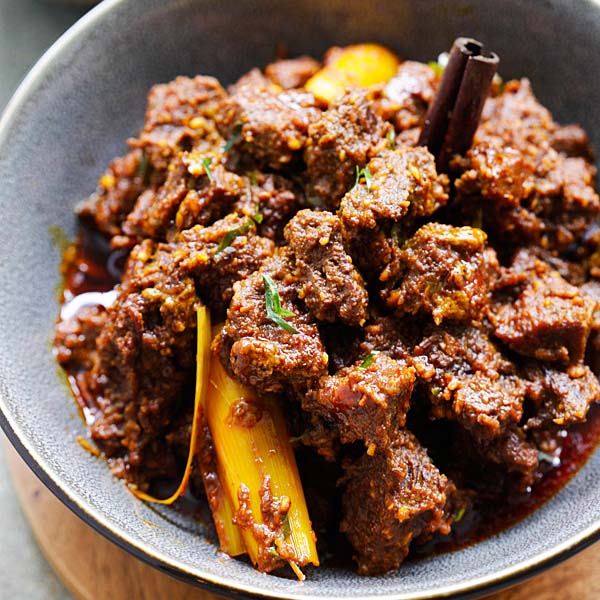
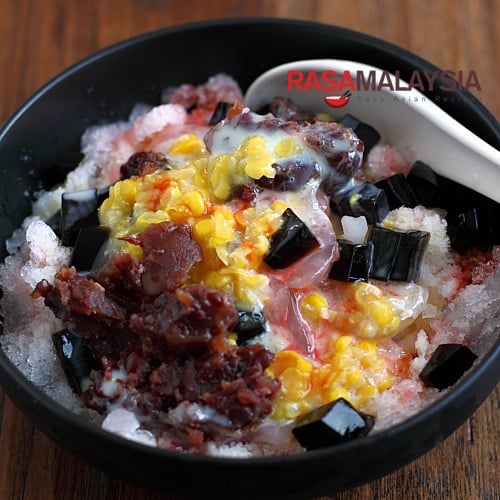






This fish recipe is BOMB.
Everyone loved this for a change from my boring butter lan seared fish. ❤️❤️❤️❤️
Hi Joseph, thanks for the comment and the 5-star rating! :)
I have tried this recipe in multiple occasions. It is excellent.
Hello Bee
Can this sambal be made without belachan. My family do not like belachan and what can I use as substitute. Thanks.
Fish sauce.
Hi can I know how many Chillies and shallots are we looking at in 6oz and 4oz respectively? Thank u.